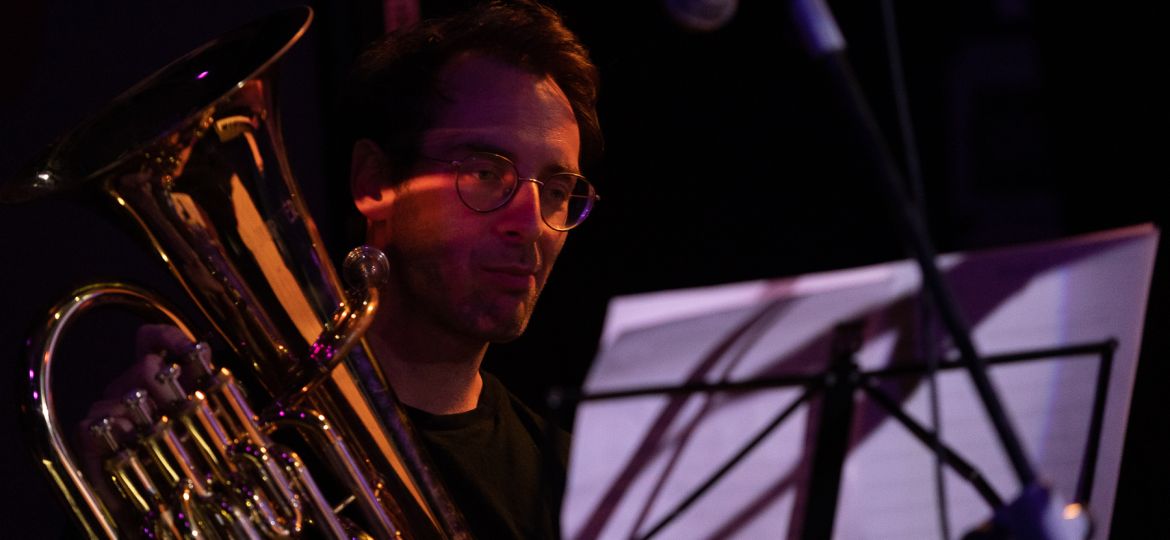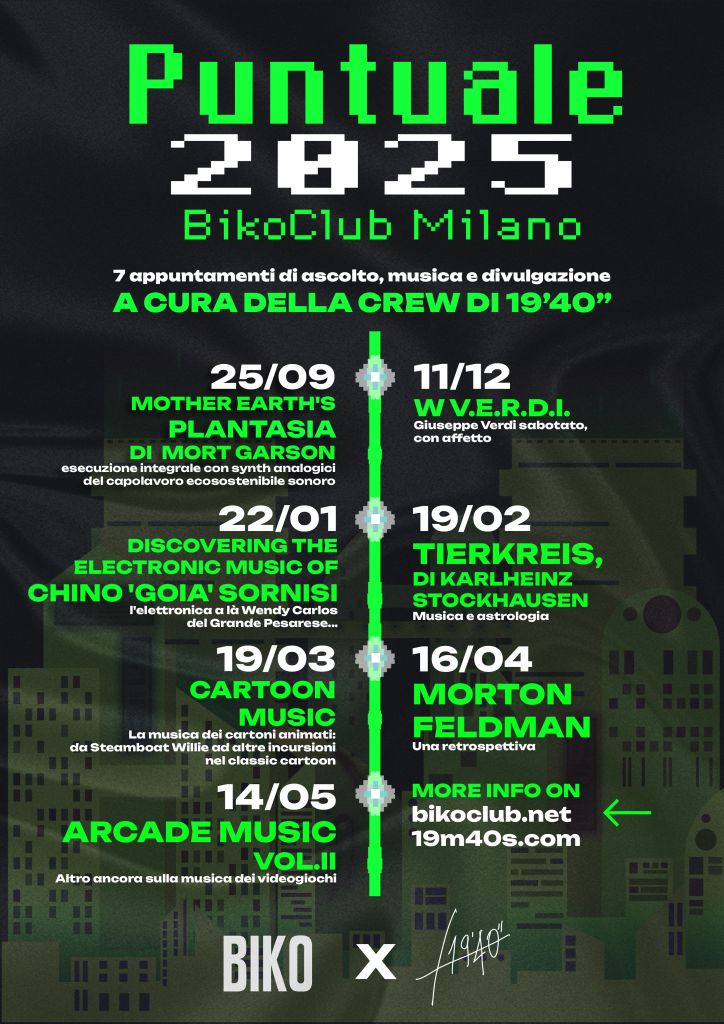

Puntuale 2025 returns, seven events curated by the 19’40” crew: discussions, concerts, analyses, retrospectives, musical and cultural explorations for all.
MOTHER EARTH’S PLANTASIA by MORT GARSON
Professor Stefano Mancuso, a leading expert in plant neurobiology, privately told us that one day a certain Mr. Mort Garson showed up at a scientific conference with a record in hand: that record was Mother Earth’s Plantasia. No one took him seriously, but over the years, history saved him from oblivion. Sometimes it happens.
Released in 1976, it has become a cult object in recent years because it’s one of the rare cases of music designed for plants and their hypothetical well-being. In an era of environmentalism of every sort, performing this record live has become a tribute to the hope for reconciliation between man and nature, which is so desired by the younger generations.
How much science is behind these compositions is still to be determined. But we, with Esecutori di Metallo su Carta, after recording it for 19’40’’ in an entirely acoustic version, have decided to present it exactly as it was. We don’t have Moogs, but we have a wonderful quartet of analog synthesizers that hold their own.
The quartet is composed of Enrico Gabrielli (on JEN SX-1000), Sebastiano De Gennaro (on KORG MS 20), Luisa Santacesaria (on MULTIVOX), and Damiano Afrifa (on JUNO-106).
Mother Earth’s Plantasia is not just a concert but a listening experience; a dimensional passage to a mental planet of bright green.
W V.E.R.D.I. Giuseppe Verdi sabotaged, with affection
Historically, December 7th in Milan marks the opening of the Teatro alla Scala, coinciding with the patron saint’s day, Sant’Ambrogio. This year, the opera on the bill is La forza del destino by Giuseppe Verdi.
Although this may seem distant from the spirit of 19’40’’, we have no qualms about tackling even a sacred duo like opera and Verdi. In 2012, our Francesco Fusaro, for example, conceived a symphonic piece titled W V.E.R.D.I. [almost an epitaph] for the 150th anniversary of Italy. It was literally an orchestral page, framed in a beautiful wooden frame, which overlaid the final chord of five Verdi operas, creating a tense, dark, and mysterious cluster. The gesture was a direct criticism of the sense of patriotism associated with state commemorations. But starting from here, we decided to name the evening after that conceptual composition. We will perform Verdi material, transcribed, revised, and (especially) sabotaged. Without ridicule, of course not! Rather, we will conduct a social experiment, in which we aim, only through music, and without the burden of operatic cliché, to spark interest in one of the greatest musicians of our past.
With contralto Francesca Biliotti, pianist and clarinetist Enrico Gabrielli, percussionist Sebastiano De Gennaro, flugelhorn and trumpet player Marcello Corti, and narration by Francesco Fusaro.
DISCOVERING THE ELECTRONIC MUSIC OF CHINO ‘GOIA’ SORNISI
Nobody knows Chino ‘Goia’ Sornisi, right? We at 19’40’’ would bet on it. How is it possible that no one knows this great, immense, extraordinary composer and pioneer of analog electronics?
Author of pieces like Fuga per quattro oscillatori pretenziosi from 1921, Encore de memento from 1968, and that shining gem of music and narration Un Petit Train électronique de Plaisir from 1927? A friend of Martenot in Paris and the inventor of the Eterodiofono? No, right? This is a classic example of a disgrace in world musicology, which has erased history for political or nationalistic reasons. Okay, yes, Delia Derbyshire, okay David Vorhaus, sure Wendy Carlos, but one cannot simply forget such an eclectic and important figure as Sornisi!
We cannot think that this eclipse was accidental. Perhaps he was so great that he overshadowed the pioneers of 20th-century Anglo-Saxon electronics? The mystery remains. We will be here, with four analog synthesizers and a narrator, to tell, illustrate, and finally do justice to the Great Pesarese of electronics. We made an entire album about him, so we know a little something (https://www.19m40s.com/07-chinogoiasornisi).
The ensemble includes Enrico Gabrielli (on JEN SX-1000), Sebastiano De Gennaro (on KORG MS 20), Luisa Santacesaria (on MULTIVOX), Damiano Afrifa (on JUNO-106), and Francesco Fusaro as the narrator.
An unmissable and unique opportunity worldwide, that’s for sure…
TIERKREIS by KARLHEINZ STOCKHAUSEN
The links between music and astrology are always a great excuse to create music that hides multiple meanings, speaks of several things simultaneously, and says something while concealing something else.
The concealment of meaning is one of the favorite games of contemporary classical composers, and in most cases, the writer leaves it up to the listener to dig and find the hidden layers. Stockhausen, however, unlike many other colleagues, always left a shovel in the corner to dig better and faster.
In 1975, Karlheinz Stockhausen composed twelve melodies, one for each zodiac sign, for the theatrical show Musik Im Bauch. The melodies, called Tierkreis, were intended for six percussionists and music boxes and were inspired by children, friends, and acquaintances born under the various zodiac signs. Stockhausen also wrote twelve texts describing the characteristics of the 12 human types linked to the signs. The bell tower of the Cologne Town Hall still uses these melodies to mark the hours of the day.
The complete performance of Tierkreis we are presenting is a transcription conceived and recorded by Sebastiano De Gennaro on toy keyboards and violin.
Esecutori di Metallo su Carta are: Alessandro Trabace on violin, Angelo Trabace, Sebastiano De Gennaro, and Enrico Gabrielli on CASIO keyboards.
CARTOON MUSIC
What links Steamboat Willie by Walt Disney, The Pink Panther, the cartoons of Gianini and Luzzati, and Bruno Bozzetto? They are all “real” cartoons, made with elbow grease, hand-drawn sketches, and hand-painted colors. Today, only Studio Ghibli continues that kind of craftsmanship. Almost everything else is now done digitally.
The music of the classical cartoon period went hand in hand with the quality of the production process: fast writing, rapid scene changes, and extensive use of classical music themes. Harry Mancini wrote the theme for The Pink Panther, George Hamilton Green performed the music for the first Disney cartoon, Cab Calloway appeared in the Betty Boop cartoons. Compositions by Franz von Suppé, Jean Sibelius, Antonio Vivaldi, Antonin Dvorak, and Ludwig van Beethoven were performed, reinvented, and distorted.
We will play and watch all this and more, together with Enrico Gabrielli on clarinet and piano, Marcello Corti on trumpet and flugelhorn, and Sebastiano De Gennaro on percussion.
MORTON FELDMAN A retrospective
For those unfamiliar with him, Morton Feldman represents something more than just an American composer, active from the late 1940s until the 1980s. He represents an ideal figure of a complete artist applied to music. Not a structure designer or a mathematician of events, but a true interdisciplinary soul merged into the score.
He knew Jackson Pollock, Mark Rothko, and Samuel Beckett well—people who spoke of the sense of the present in a decidedly non-academic way. And, above all, they were not historicized.
We will perform two pieces: The King of Denmark (1965) for percussion and Bass Clarinet and Percussion (1981).
We will do this together with a great guest and friend: Elio Marchesini on percussion, one of Italy’s leading experts in contemporary percussion. With him will be Sebastiano De Gennaro on percussion, Enrico Gabrielli on bass clarinet, and Francesco Fusaro narrating Feldman in a few simple and “punctual” words.
ARCADE MUSIC VOL.II
After last year’s ARCADE MUSIC, which concluded the previous series of Puntuale events, we at 19’40” decided NOT to close the chapter on video game soundtracks. Quite the opposite! We’re picking up right where we left off, with the music from Ghosts’n Ghouls by Tim Follin and TzO The Ghost Game by Sebastiano De Gennaro.
And we will try to go even further, with the music of David Kanaga, famous themes like Zelda, and the presentation of a recently produced game.
Coin on. Push button…